中考英语语法考点总结——代词(共30张PPT)
文档属性
| 名称 | 中考英语语法考点总结——代词(共30张PPT) | 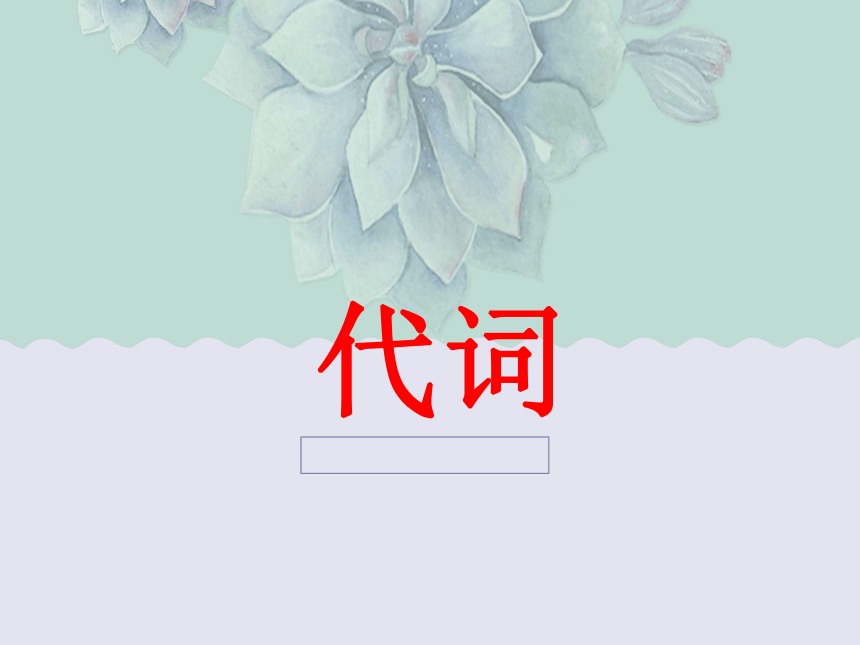 | |
| 格式 | ppt | ||
| 文件大小 | 3.3MB | ||
| 资源类型 | 试卷 | ||
| 版本资源 | 通用版 | ||
| 科目 | 英语 | ||
| 更新时间 | 2022-04-10 18:51:26 | ||
图片预览

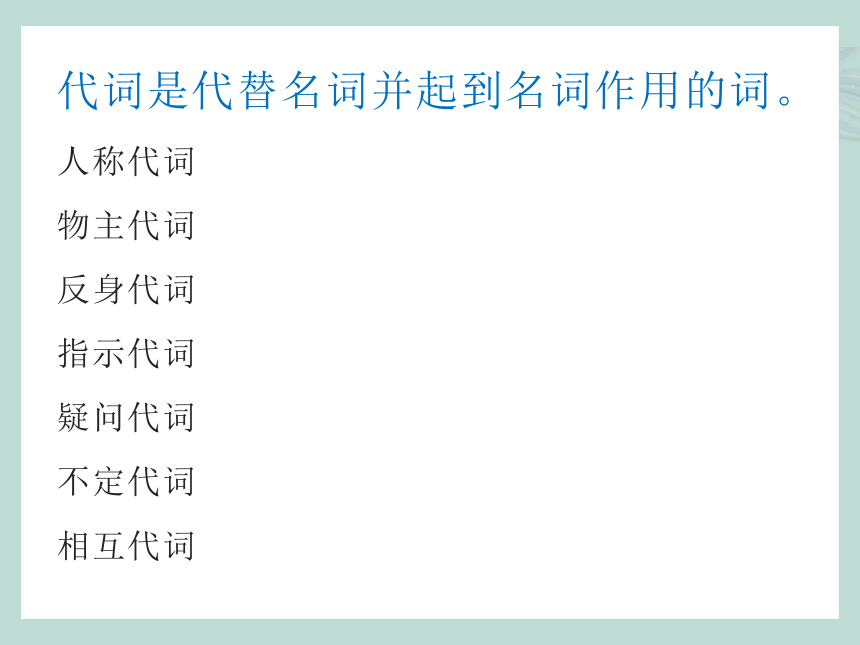
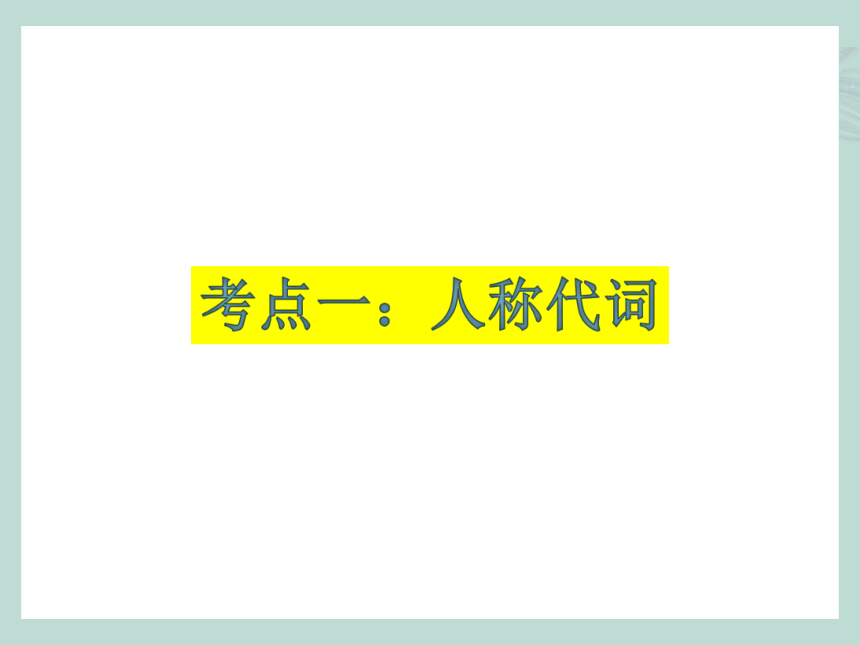
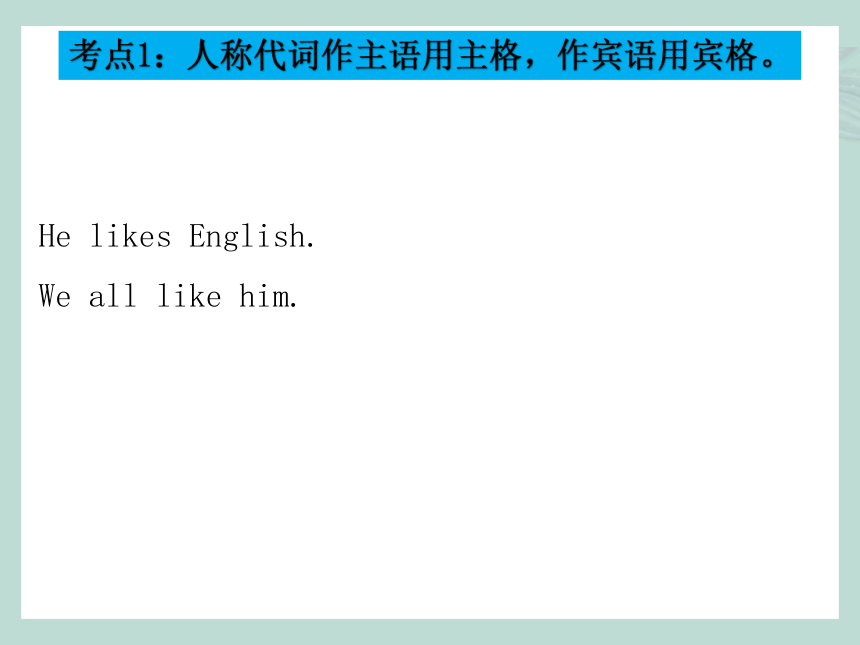
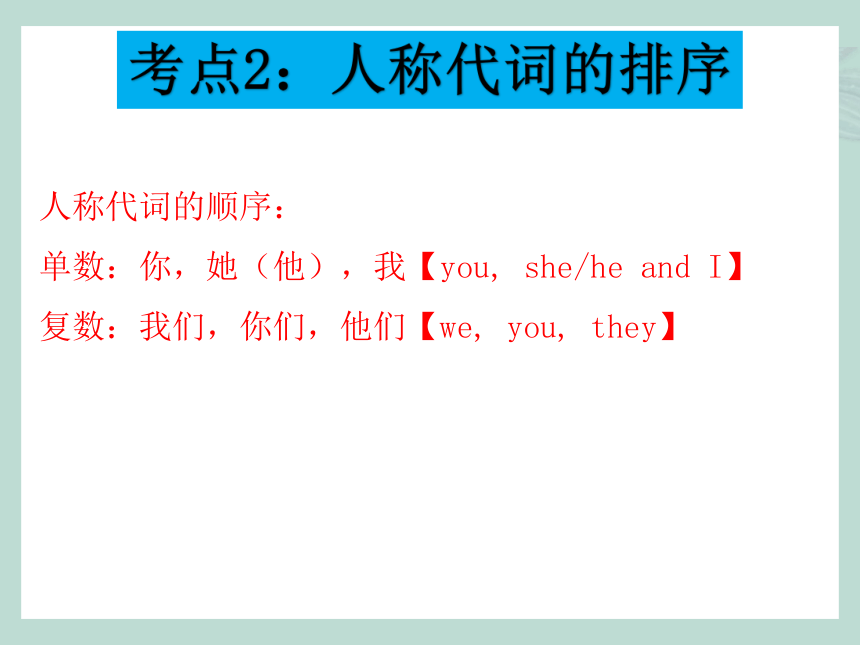
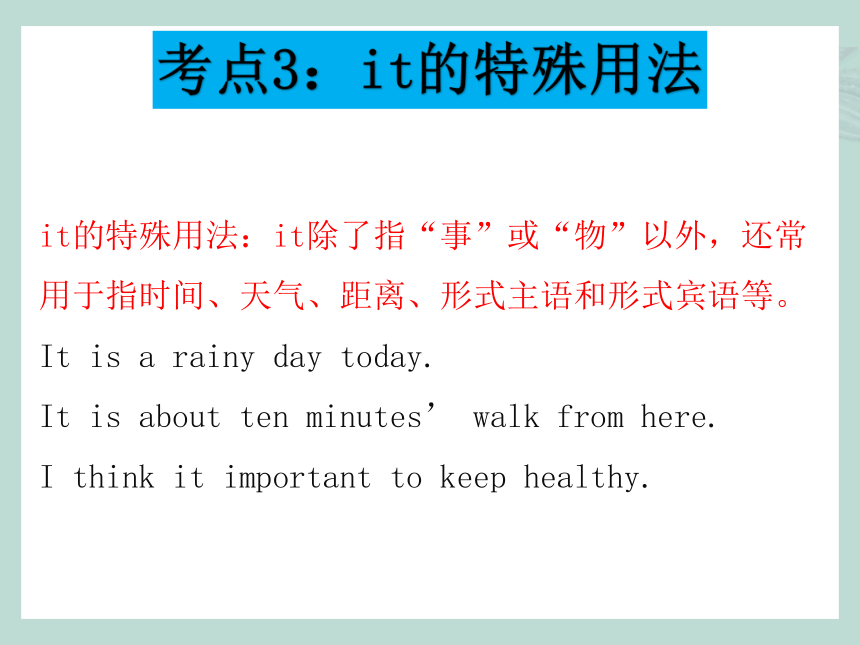
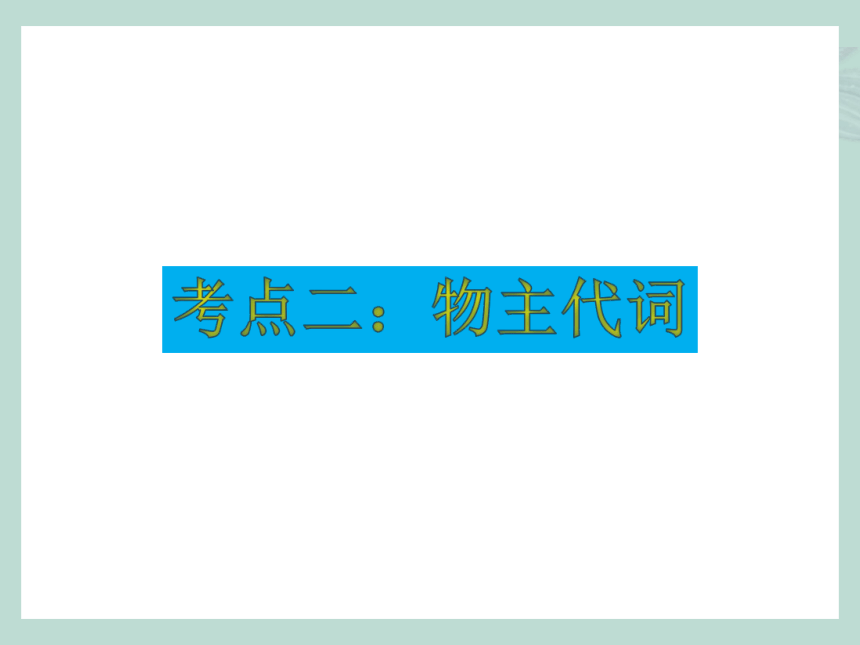
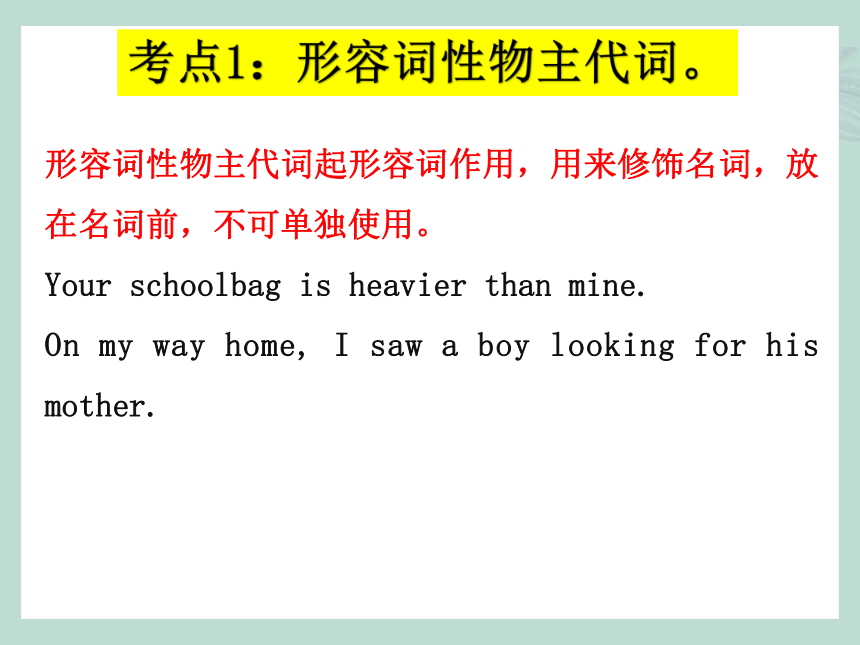
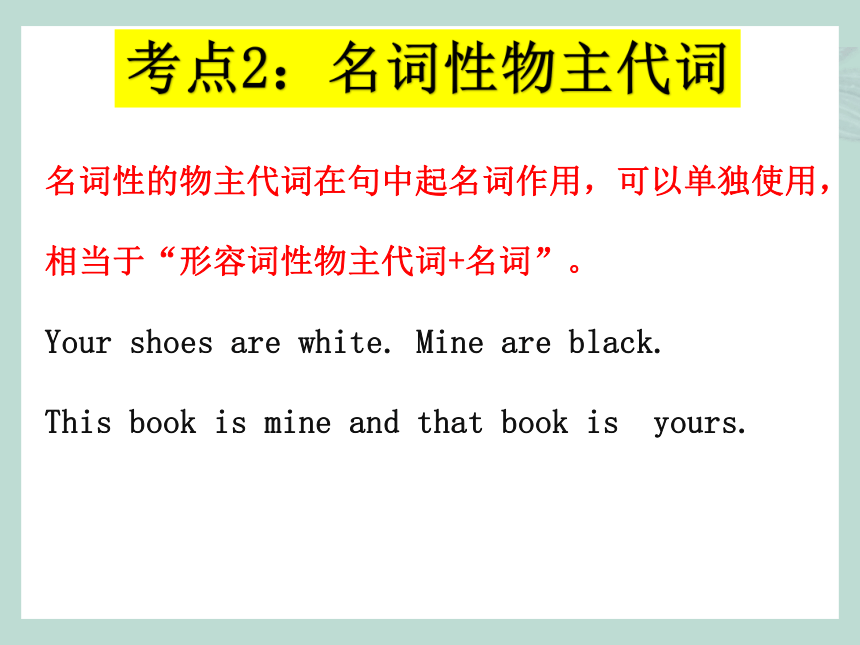
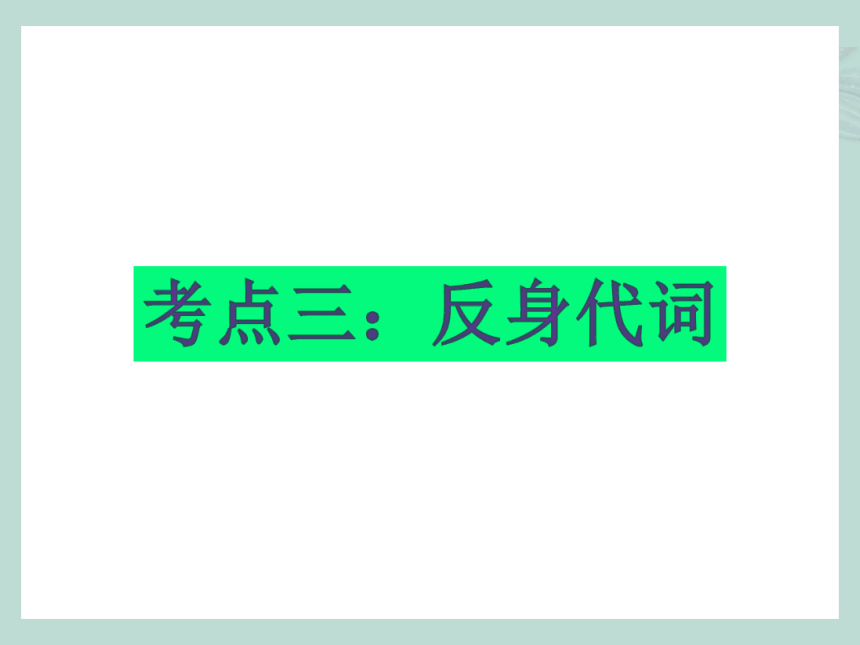
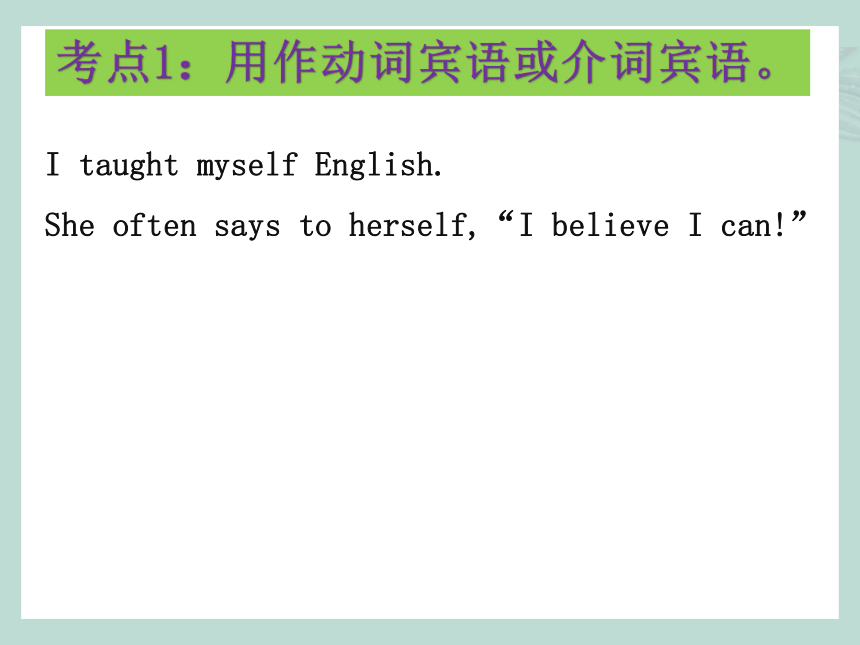
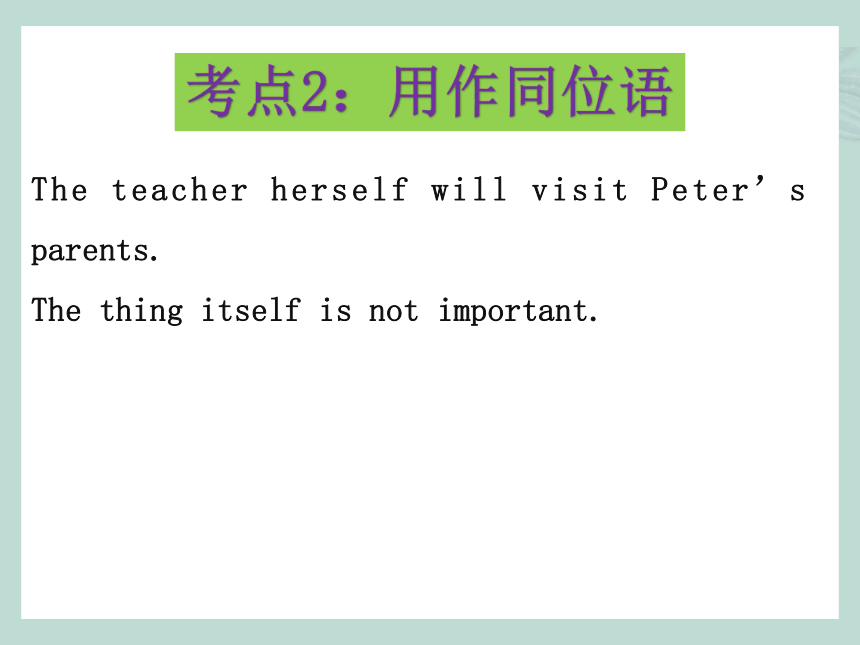
文档简介
(共30张PPT)
代词
代词是代替名词并起到名词作用的词。
人称代词
物主代词
反身代词
指示代词
疑问代词
不定代词
相互代词
考点1:人称代词作主语用主格,作宾语用宾格。
He likes English.
We all like him.
考点2:人称代词的排序
人称代词的顺序:
单数:你,她(他),我【you, she/he and I】
复数:我们,你们,他们【we, you, they】
考点3:it的特殊用法
it的特殊用法:it除了指“事”或“物”以外,还常用于指时间、天气、距离、形式主语和形式宾语等。
It is a rainy day today.
It is about ten minutes’ walk from here.
I think it important to keep healthy.
考点1:形容词性物主代词。
形容词性物主代词起形容词作用,用来修饰名词,放在名词前,不可单独使用。
Your schoolbag is heavier than mine.
On my way home, I saw a boy looking for his mother.
考点2:名词性物主代词
名词性的物主代词在句中起名词作用,可以单独使用,相当于“形容词性物主代词+名词”。
Your shoes are white. Mine are black.
This book is mine and that book is yours.
考点1:用作动词宾语或介词宾语。
I taught myself English.
She often says to herself,“I believe I can!”
考点2:用作同位语
The teacher herself will visit Peter’s parents.
The thing itself is not important.
考点3:常用的含有反身代词的固定词组
by oneself 独自
help oneself to… 随便吃……
make oneself at home 别拘束,像在自己家一样
enjoy oneself 玩得开心
hurt oneself 弄伤自己
teach oneself 自学
say to oneself 自言自语
表示“这个,那个,这些,那些”指向性的代词为指示代词,主要有:this, that, these, those。其中this, these指在时间或空间上离说话人较近的人或物; that, those指在时间或空间上离说话人较远的人或物。this和that指代的是单数名词, these和those指代的是复数名词。
Look at these desks. They are all new.
Please pass me those tomatoes in that room and I want to cook some soup.
电话用语中,This is…表示“我是……” Is that… 表示“你是……吗?”
---Hello, is____ Tom speaking
---Yes, this is Tom speaking.
A. this B. that C. it D. these
that, those常用来代替前面出现过的名词或名词词组,以免重复。
The apples in that box are bigger than_____ in this box.
A. that B. those C. these D. this
疑问代词主要有 which(哪一个), who/whom(谁), whose(谁的), what(什么),它们和一些疑问副词how, when, where, why等用法类似,放在句首,后面跟一般疑问句,构成特殊疑问句。
---________do you prefer, tea or coffee
---Tea, please.
A. What B. How C. Where D. Which
考点1:one和ones的用法
one/ones 指人或物,可作主语、表语和宾语。
one 用来替代前面的单数名词,ones用来替代前面的复数名词,以避免重复。
Red apples often taste better than green ______.
A. one B. ones C. its D. this
考点2:either, neither, both和all的用法
either 两者中的任何一个。
neither 两者都不。
both 两者都。
all 三者或以上都。
There are a lot of trees on ______ side of the street.
A.both B. every C. either D. all
考点3:the other, another的用法
the other表示(两者中的)另一个。
another 表示(多个中的)另一个。
I have two uncles. One is a policeman and _______ is a doctor.
A. the other B. another C. others D. the others
考点4:others和the others的用法
others表示别的,另一些(人或物),不包括所有其余的。
the others表示所有其余的。
I have got ten pencils. Two of them are red and _______ are blue.
A. the others B. the other C. others D. another
考点5:some和any的用法
some表示一些,一般用于肯定句中。
any 表示一些,用于否定句和一般疑问句中。
Do you have _____ water here
A. some B. any C. few D. many
1.疑问句一般不用some,只有当表示邀请或期待对方做出肯定回答时才能用some。
例如:Would you like some coffee 你想要来点咖啡吗?
2.some修饰可数名词单数时,不是“一些”的含义,而是“某个”。
例如:He’s waiting for some friend.他在等某个朋友。
3.any 用于肯定句,后面修饰可数名词单数时,表示“任一”。
例如:The teacher likes any student in her class. 这个老师喜欢他班里的每一个学生。
考点6:(a)few和(a)little的用法
few, little:几乎没有(否定语气)
a few, a little: 一些,少数(肯定语气)
few, a few指可数的事物,只能与可数名词复数搭配
little, a little指不可数事物,只能与不可数名词搭配
Let’s buy some milk. There is _____ in the fridge.
A. few B. a few C. little D. a little
考点7:many和much的用法
many表示许多,指可数的事物,只能与可数名词复数搭配;
much表示许多,指不可数的事物,只能与不可数名词搭配。
Would you like to have a look at my stamps I have ____.
A. much B. many C. little D. a little
考点8:复合不定代词的用法
some-, any-, every-和no-可以分别和-thing, -body, -one构成合成不定代词。
下面以-thing为例:something表示某事,用于肯定句;
anything 表示某事,用于否定句和一般疑问句;表示任何事时,可用于肯定句;everything表示一切事;nothing表示没什么。
注意:修饰合成不定代词的定语要放在它们后面。
Something terrible happened during our trip to that mountain.
THANK YOU
代词
代词是代替名词并起到名词作用的词。
人称代词
物主代词
反身代词
指示代词
疑问代词
不定代词
相互代词
考点1:人称代词作主语用主格,作宾语用宾格。
He likes English.
We all like him.
考点2:人称代词的排序
人称代词的顺序:
单数:你,她(他),我【you, she/he and I】
复数:我们,你们,他们【we, you, they】
考点3:it的特殊用法
it的特殊用法:it除了指“事”或“物”以外,还常用于指时间、天气、距离、形式主语和形式宾语等。
It is a rainy day today.
It is about ten minutes’ walk from here.
I think it important to keep healthy.
考点1:形容词性物主代词。
形容词性物主代词起形容词作用,用来修饰名词,放在名词前,不可单独使用。
Your schoolbag is heavier than mine.
On my way home, I saw a boy looking for his mother.
考点2:名词性物主代词
名词性的物主代词在句中起名词作用,可以单独使用,相当于“形容词性物主代词+名词”。
Your shoes are white. Mine are black.
This book is mine and that book is yours.
考点1:用作动词宾语或介词宾语。
I taught myself English.
She often says to herself,“I believe I can!”
考点2:用作同位语
The teacher herself will visit Peter’s parents.
The thing itself is not important.
考点3:常用的含有反身代词的固定词组
by oneself 独自
help oneself to… 随便吃……
make oneself at home 别拘束,像在自己家一样
enjoy oneself 玩得开心
hurt oneself 弄伤自己
teach oneself 自学
say to oneself 自言自语
表示“这个,那个,这些,那些”指向性的代词为指示代词,主要有:this, that, these, those。其中this, these指在时间或空间上离说话人较近的人或物; that, those指在时间或空间上离说话人较远的人或物。this和that指代的是单数名词, these和those指代的是复数名词。
Look at these desks. They are all new.
Please pass me those tomatoes in that room and I want to cook some soup.
电话用语中,This is…表示“我是……” Is that… 表示“你是……吗?”
---Hello, is____ Tom speaking
---Yes, this is Tom speaking.
A. this B. that C. it D. these
that, those常用来代替前面出现过的名词或名词词组,以免重复。
The apples in that box are bigger than_____ in this box.
A. that B. those C. these D. this
疑问代词主要有 which(哪一个), who/whom(谁), whose(谁的), what(什么),它们和一些疑问副词how, when, where, why等用法类似,放在句首,后面跟一般疑问句,构成特殊疑问句。
---________do you prefer, tea or coffee
---Tea, please.
A. What B. How C. Where D. Which
考点1:one和ones的用法
one/ones 指人或物,可作主语、表语和宾语。
one 用来替代前面的单数名词,ones用来替代前面的复数名词,以避免重复。
Red apples often taste better than green ______.
A. one B. ones C. its D. this
考点2:either, neither, both和all的用法
either 两者中的任何一个。
neither 两者都不。
both 两者都。
all 三者或以上都。
There are a lot of trees on ______ side of the street.
A.both B. every C. either D. all
考点3:the other, another的用法
the other表示(两者中的)另一个。
another 表示(多个中的)另一个。
I have two uncles. One is a policeman and _______ is a doctor.
A. the other B. another C. others D. the others
考点4:others和the others的用法
others表示别的,另一些(人或物),不包括所有其余的。
the others表示所有其余的。
I have got ten pencils. Two of them are red and _______ are blue.
A. the others B. the other C. others D. another
考点5:some和any的用法
some表示一些,一般用于肯定句中。
any 表示一些,用于否定句和一般疑问句中。
Do you have _____ water here
A. some B. any C. few D. many
1.疑问句一般不用some,只有当表示邀请或期待对方做出肯定回答时才能用some。
例如:Would you like some coffee 你想要来点咖啡吗?
2.some修饰可数名词单数时,不是“一些”的含义,而是“某个”。
例如:He’s waiting for some friend.他在等某个朋友。
3.any 用于肯定句,后面修饰可数名词单数时,表示“任一”。
例如:The teacher likes any student in her class. 这个老师喜欢他班里的每一个学生。
考点6:(a)few和(a)little的用法
few, little:几乎没有(否定语气)
a few, a little: 一些,少数(肯定语气)
few, a few指可数的事物,只能与可数名词复数搭配
little, a little指不可数事物,只能与不可数名词搭配
Let’s buy some milk. There is _____ in the fridge.
A. few B. a few C. little D. a little
考点7:many和much的用法
many表示许多,指可数的事物,只能与可数名词复数搭配;
much表示许多,指不可数的事物,只能与不可数名词搭配。
Would you like to have a look at my stamps I have ____.
A. much B. many C. little D. a little
考点8:复合不定代词的用法
some-, any-, every-和no-可以分别和-thing, -body, -one构成合成不定代词。
下面以-thing为例:something表示某事,用于肯定句;
anything 表示某事,用于否定句和一般疑问句;表示任何事时,可用于肯定句;everything表示一切事;nothing表示没什么。
注意:修饰合成不定代词的定语要放在它们后面。
Something terrible happened during our trip to that mountain.
THANK YOU
同课章节目录
- 词法
- 名词
- 动词和动词短语
- 动词语态
- 动词时态
- 助动词和情态动词
- 非谓语动词
- 冠词
- 代词
- 数词和量词
- 形容词副词及其比较等级
- 介词和介词短语
- 连词和感叹词
- 构词法
- 相似、相近词比较
- 句法
- 陈述句
- 一般疑问句和否定疑问句
- 特殊疑问句及选择疑问句
- 反意疑问句
- 存在句(There be句型)
- 宾语从句
- 定语从句
- 状语从句
- 主谓一致问题
- 简单句
- 并列句
- 复合句
- 主谓一致
- 主、表语从句
- 名词性从句
- 直接引语和间接引语
- 虚拟语气
- 感叹句
- 强调句
- 倒装句
- 祈使句
- 句子的成分
- 句子的分类
- 题型专区
- 单项选择部分
- 易错题
- 完形填空
- 阅读理解
- 词汇练习
- 听说训练
- 句型转换
- 补全对话
- 短文改错
- 翻译
- 书面表达
- 任务型阅读
- 语法填空
- 其他资料
